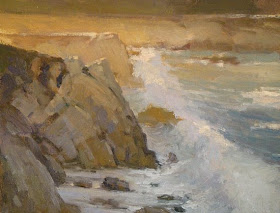
The Golden Shore
.
The rule about warm colours in the foreground and cool in the distance can be broken.
In this example, the warm pink is in the background, cool in the foreground.
The figure on the rock (at a golden mean point) acts as the visual hinge.
The white clouds at the top of the painting balance the white foam at the bottom.
Sea foam is not always pure white - seascape painters often add a little mauve to distant foam, and a little of a warm cream colour to foreground foam. Here, however, the foreground foam is in a cool shadow. There may be hints of pink in it - hard to tell in this reproduction. Highlights of purer white can be reserved for points where the sun catches the crest of a wave or plume of spray.
.
.
Another example of cool foreground- warm background. The background colours still need to be lower in saturation, to give a sense of aerial perspective.
.
Catalina Sailing, 14 x 18 inches
Ken Backhaus - American































.jpg)

















